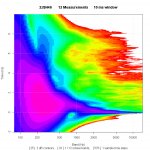A little over a year ago I purchased 4 Danley SH46s which have become the focus of my on-and-off-again efforts to develop a process for deriving speaker settings from measurements. I finally have something that I think is at least worth a listen, bearing in mind that this is a work in progress.
Without going into too much detail, the FIR part applies above 360 Hz, which turns out to be a convenient lower limit for the nonminimum phase part. The filter is based on 15 pseudo free-field (IR windowed at 10 ms) measurements taken on an arrayed pair (as they would conventionally be deployed) at 5 horizontal and 3 vertical 10 degree increments.
The IIR part is based on 3 ground plane measurement evaluated from ~90 to 800 Hz. They are expressed in terms of Powersoft AESOP parameters. As an aside, I reverse engineered the Powersoft peaking filters and found them to have the following transfer function in terms of their parameters.
if (A >= 1){
a[2] <- w / (Q * 2)
b[2] <- A * w / (Q * 2)
}
if (A < 1){
a[2] <- w / (Q * 2) / A
b[2] <- w / (Q * 2)
}
a[3] <- 1
b[3] <- 1
a[1] <- w^2
b[1] <- w^2
H <- (b[1] + b[2]*s + b[3]*s^2) / (a[1] + a[2]*s + a[3]*s^2)
Where A is the boost or cut, w is the (radian) center frequency, and Q is what they call "Q". I don't know what their variable-slope shelving filters do, I just slide around the parameters to fit the desired response curve by eye.
The IIR parameters are:
1. peaking, 271 Hz, -2.6 dB, Q = 4
2. low shelf, 182 Hz, +4.5 dB, slope = 1.19 octave
The FIR part is in the attached file of 384 taps at 48kHz and has a processing delay of 4.1 ms.
Now that I think I'm getting somewhere with the process I'm looking forward to getting more (angular resolution) and better measurements and refining all this.
Here are before and after TFE plots averaged across all measurement angles. The contour interval is 2 dB.


--Frank
For some reason the forum software is not letting me upload the file. It says "invalid file". So here it is inline. Cut and paste away:
-0.002846245
0.003043455
-0.00276923
0.003183166
-0.002690172
0.003323643
-0.002614173
0.003459903
-0.002546179
0.003587006
-0.002491371
0.003699509
-0.00245552
0.003791587
-0.002444295
0.003858145
-0.002462075
0.003895692
-0.00251168
0.003901949
-0.002595197
0.003875004
-0.002714406
0.003813583
-0.00286981
0.00371843
-0.003059345
0.003593022
-0.003278498
0.003442673
-0.003521621
0.003273337
-0.00378252
0.003091872
-0.004053465
0.002907288
-0.0043243
0.002730785
-0.004583431
0.002573956
-0.004819876
0.002447176
-0.005023911
0.002360062
-0.005185813
0.002322874
-0.00529506
0.002346189
-0.005341876
0.002438524
-0.005319704
0.002604548
-0.005225818
0.002845676
-0.00505999
0.003161346
-0.004824032
0.003548249
-0.004523666
0.003998031
-0.004170323
0.004496791
-0.003779983
0.00502765
-0.003370048
0.005573333
-0.002958188
0.00611556
-0.002564373
0.006632562
-0.002212585
0.00709909
-0.00192878
0.007490043
-0.00173672
0.00778393
-0.001656179
0.007962722
-0.00170449
0.008010036
-0.001897404
0.00791208
-0.002246242
0.007661684
-0.002753941
0.007260912
-0.003414569
0.006719466
-0.004216118
0.006052055
-0.005141744
0.005279155
-0.006167294
0.004430126
-0.007259
0.003543508
-0.008375619
0.002662996
-0.009473055
0.001833736
-0.0105061
0.001102693
-0.01142685
0.0005199193
-0.01218529
0.0001352402
-0.01273506
-8.458983e-06
-0.01303919
0.0001216556
-0.0130699
0.000551128
-0.01280522
0.001299965
-0.01223067
0.002377216
-0.01134705
0.003773337
-0.01017512
0.005460484
-0.008750374
0.007400613
-0.007115449
0.009549214
-0.005322337
0.0118475
-0.003443156
0.01421279
-0.001574899
0.01654061
0.0001686628
0.01871554
0.001666027
0.02061516
0.002786222
0.02210577
0.003387647
0.0230508
0.003339845
0.0233453
0.002564316
0.0229531
0.001057102
0.021908
-0.001131846
0.02027927
-0.003933987
0.01815009
-0.007261096
0.01564132
-0.01097112
0.01293651
-0.0148746
0.0102299
-0.01883367
0.00759859
-0.02288747
0.004919605
-0.02726065
0.001953798
-0.03219717
-0.001436282
-0.03774304
-0.005119298
-0.04367251
-0.008724615
-0.04960976
-0.01180809
-0.05519054
-0.01394921
-0.06007289
-0.01465905
-0.06378372
-0.01319234
-0.06557381
-0.008459693
-0.06445388
0.0008555229
-0.05945104
0.01599987
-0.05005392
0.03771801
-0.03684286
0.06575142
-0.02224977
0.09856379
-0.01120144
0.1340354
-0.01148801
0.1725233
-0.03527935
0.2270285
-0.1132232
0.3895175
-0.5656818
-0.8247156
1
-0.373733
0.1444993
-0.1070597
0.087523
-0.0804411
0.1114505
-0.09976711
0.05478278
-0.006782236
0.05348903
-0.1001743
0.0205883
-0.03252572
0.03616147
-0.03986971
0.03301972
-0.02416735
0.05882376
0.002909336
0.02481995
-0.04357157
0.02974635
-0.002310344
0.02982877
-0.03515127
-0.0002781205
-0.03872917
0.006014976
-0.03083049
0.005342594
-0.02859317
0.01282665
-0.01522705
0.01854458
-0.01323903
0.02129957
-0.006068769
0.02227558
-0.007537886
0.02155246
-0.004778915
0.02151843
-0.006865039
0.0145083
-0.01245116
0.01371691
-0.008446633
0.01424334
-0.009916231
0.01147236
-0.01183383
0.008576406
-0.01355354
0.006880111
-0.01295033
0.007568829
-0.01245254
0.007413197
-0.01022552
0.008774196
-0.01057738
0.007894689
-0.007923326
0.01132995
-0.005827832
0.01082909
-0.005795221
0.0114592
-0.004476211
0.0110546
-0.005834086
0.009349459
-0.006024855
0.008817963
-0.006974408
0.007553446
-0.006915541
0.007518867
-0.00710381
0.006513059
-0.007719228
0.005928743
-0.008003979
0.004613789
-0.00920161
0.004008224
-0.008857311
0.003791995
-0.008779559
0.004110667
-0.008186194
0.004080935
-0.007750033
0.00458596
-0.00722885
0.004538535
-0.006936749
0.004781081
-0.006558243
0.00456012
-0.006714255
0.004728302
-0.005757906
0.005006188
-0.006101344
0.004537567
-0.00594439
0.004300864
-0.006294053
0.003860135
-0.006420301
0.003668634
-0.006197419
0.003730702
-0.006070226
0.003988973
-0.005187416
0.004698524
-0.004605529
0.005086675
-0.003863051
0.005758935
-0.003206228
0.005992879
-0.002983469
0.006057148
-0.002871562
0.00578275
-0.003159737
0.005396986
-0.003402257
0.004977932
-0.003642391
0.004659834
-0.003868587
0.004345518
-0.003982391
0.004138676
-0.003936997
0.004247797
-0.003772699
0.004162392
-0.003725634
0.004065882
-0.003773151
0.00409705
-0.003515313
0.003986036
-0.003738801
0.003809289
-0.003625462
0.003837922
-0.00360274
0.003614061
-0.003716097
0.003637517
-0.003534918
0.003524896
-0.003626377
0.00350085
-0.003459179
0.003581244
-0.003332072
0.003532629
-0.003282214
0.003676442
-0.003033149
0.00365808
-0.002986955
0.00377236
-0.002873019
0.003600018
-0.002937467
0.003614102
-0.002877803
0.003463092
-0.003003564
0.003318035
-0.002993832
0.003290372
-0.002993211
0.003209294
-0.002960532
0.00317265
-0.002953917
0.003167701
-0.002866221
Without going into too much detail, the FIR part applies above 360 Hz, which turns out to be a convenient lower limit for the nonminimum phase part. The filter is based on 15 pseudo free-field (IR windowed at 10 ms) measurements taken on an arrayed pair (as they would conventionally be deployed) at 5 horizontal and 3 vertical 10 degree increments.
The IIR part is based on 3 ground plane measurement evaluated from ~90 to 800 Hz. They are expressed in terms of Powersoft AESOP parameters. As an aside, I reverse engineered the Powersoft peaking filters and found them to have the following transfer function in terms of their parameters.
if (A >= 1){
a[2] <- w / (Q * 2)
b[2] <- A * w / (Q * 2)
}
if (A < 1){
a[2] <- w / (Q * 2) / A
b[2] <- w / (Q * 2)
}
a[3] <- 1
b[3] <- 1
a[1] <- w^2
b[1] <- w^2
H <- (b[1] + b[2]*s + b[3]*s^2) / (a[1] + a[2]*s + a[3]*s^2)
Where A is the boost or cut, w is the (radian) center frequency, and Q is what they call "Q". I don't know what their variable-slope shelving filters do, I just slide around the parameters to fit the desired response curve by eye.
The IIR parameters are:
1. peaking, 271 Hz, -2.6 dB, Q = 4
2. low shelf, 182 Hz, +4.5 dB, slope = 1.19 octave
The FIR part is in the attached file of 384 taps at 48kHz and has a processing delay of 4.1 ms.
Now that I think I'm getting somewhere with the process I'm looking forward to getting more (angular resolution) and better measurements and refining all this.
Here are before and after TFE plots averaged across all measurement angles. The contour interval is 2 dB.


--Frank
For some reason the forum software is not letting me upload the file. It says "invalid file". So here it is inline. Cut and paste away:
-0.002846245
0.003043455
-0.00276923
0.003183166
-0.002690172
0.003323643
-0.002614173
0.003459903
-0.002546179
0.003587006
-0.002491371
0.003699509
-0.00245552
0.003791587
-0.002444295
0.003858145
-0.002462075
0.003895692
-0.00251168
0.003901949
-0.002595197
0.003875004
-0.002714406
0.003813583
-0.00286981
0.00371843
-0.003059345
0.003593022
-0.003278498
0.003442673
-0.003521621
0.003273337
-0.00378252
0.003091872
-0.004053465
0.002907288
-0.0043243
0.002730785
-0.004583431
0.002573956
-0.004819876
0.002447176
-0.005023911
0.002360062
-0.005185813
0.002322874
-0.00529506
0.002346189
-0.005341876
0.002438524
-0.005319704
0.002604548
-0.005225818
0.002845676
-0.00505999
0.003161346
-0.004824032
0.003548249
-0.004523666
0.003998031
-0.004170323
0.004496791
-0.003779983
0.00502765
-0.003370048
0.005573333
-0.002958188
0.00611556
-0.002564373
0.006632562
-0.002212585
0.00709909
-0.00192878
0.007490043
-0.00173672
0.00778393
-0.001656179
0.007962722
-0.00170449
0.008010036
-0.001897404
0.00791208
-0.002246242
0.007661684
-0.002753941
0.007260912
-0.003414569
0.006719466
-0.004216118
0.006052055
-0.005141744
0.005279155
-0.006167294
0.004430126
-0.007259
0.003543508
-0.008375619
0.002662996
-0.009473055
0.001833736
-0.0105061
0.001102693
-0.01142685
0.0005199193
-0.01218529
0.0001352402
-0.01273506
-8.458983e-06
-0.01303919
0.0001216556
-0.0130699
0.000551128
-0.01280522
0.001299965
-0.01223067
0.002377216
-0.01134705
0.003773337
-0.01017512
0.005460484
-0.008750374
0.007400613
-0.007115449
0.009549214
-0.005322337
0.0118475
-0.003443156
0.01421279
-0.001574899
0.01654061
0.0001686628
0.01871554
0.001666027
0.02061516
0.002786222
0.02210577
0.003387647
0.0230508
0.003339845
0.0233453
0.002564316
0.0229531
0.001057102
0.021908
-0.001131846
0.02027927
-0.003933987
0.01815009
-0.007261096
0.01564132
-0.01097112
0.01293651
-0.0148746
0.0102299
-0.01883367
0.00759859
-0.02288747
0.004919605
-0.02726065
0.001953798
-0.03219717
-0.001436282
-0.03774304
-0.005119298
-0.04367251
-0.008724615
-0.04960976
-0.01180809
-0.05519054
-0.01394921
-0.06007289
-0.01465905
-0.06378372
-0.01319234
-0.06557381
-0.008459693
-0.06445388
0.0008555229
-0.05945104
0.01599987
-0.05005392
0.03771801
-0.03684286
0.06575142
-0.02224977
0.09856379
-0.01120144
0.1340354
-0.01148801
0.1725233
-0.03527935
0.2270285
-0.1132232
0.3895175
-0.5656818
-0.8247156
1
-0.373733
0.1444993
-0.1070597
0.087523
-0.0804411
0.1114505
-0.09976711
0.05478278
-0.006782236
0.05348903
-0.1001743
0.0205883
-0.03252572
0.03616147
-0.03986971
0.03301972
-0.02416735
0.05882376
0.002909336
0.02481995
-0.04357157
0.02974635
-0.002310344
0.02982877
-0.03515127
-0.0002781205
-0.03872917
0.006014976
-0.03083049
0.005342594
-0.02859317
0.01282665
-0.01522705
0.01854458
-0.01323903
0.02129957
-0.006068769
0.02227558
-0.007537886
0.02155246
-0.004778915
0.02151843
-0.006865039
0.0145083
-0.01245116
0.01371691
-0.008446633
0.01424334
-0.009916231
0.01147236
-0.01183383
0.008576406
-0.01355354
0.006880111
-0.01295033
0.007568829
-0.01245254
0.007413197
-0.01022552
0.008774196
-0.01057738
0.007894689
-0.007923326
0.01132995
-0.005827832
0.01082909
-0.005795221
0.0114592
-0.004476211
0.0110546
-0.005834086
0.009349459
-0.006024855
0.008817963
-0.006974408
0.007553446
-0.006915541
0.007518867
-0.00710381
0.006513059
-0.007719228
0.005928743
-0.008003979
0.004613789
-0.00920161
0.004008224
-0.008857311
0.003791995
-0.008779559
0.004110667
-0.008186194
0.004080935
-0.007750033
0.00458596
-0.00722885
0.004538535
-0.006936749
0.004781081
-0.006558243
0.00456012
-0.006714255
0.004728302
-0.005757906
0.005006188
-0.006101344
0.004537567
-0.00594439
0.004300864
-0.006294053
0.003860135
-0.006420301
0.003668634
-0.006197419
0.003730702
-0.006070226
0.003988973
-0.005187416
0.004698524
-0.004605529
0.005086675
-0.003863051
0.005758935
-0.003206228
0.005992879
-0.002983469
0.006057148
-0.002871562
0.00578275
-0.003159737
0.005396986
-0.003402257
0.004977932
-0.003642391
0.004659834
-0.003868587
0.004345518
-0.003982391
0.004138676
-0.003936997
0.004247797
-0.003772699
0.004162392
-0.003725634
0.004065882
-0.003773151
0.00409705
-0.003515313
0.003986036
-0.003738801
0.003809289
-0.003625462
0.003837922
-0.00360274
0.003614061
-0.003716097
0.003637517
-0.003534918
0.003524896
-0.003626377
0.00350085
-0.003459179
0.003581244
-0.003332072
0.003532629
-0.003282214
0.003676442
-0.003033149
0.00365808
-0.002986955
0.00377236
-0.002873019
0.003600018
-0.002937467
0.003614102
-0.002877803
0.003463092
-0.003003564
0.003318035
-0.002993832
0.003290372
-0.002993211
0.003209294
-0.002960532
0.00317265
-0.002953917
0.003167701
-0.002866221






